Enhanced Growth of Mungbean and Remediation of Petroleum Hydrocarbons by Enterobacter sp. MN17 and Biochar Addition in Diesel Contaminated Soil
Abstract
:1. Introduction
2. Materials and Methods
2.1. Experimental Design
2.2. Physicochemical Properties of Soil and Biochar
2.3. Seedling Emergence, Physiological and Growth Attributes of Mungbean Plants
2.4. Petroleum Hydrocarbons Analysis of Soil
2.5. Statistical Analysis
3. Results
3.1. Seedling Emergence and Agronomic Parameters of Mungbean Plants
3.2. Physiological Attributes of Mungbean Plants
3.3. Nutrient Uptake by Mungbean Plants
3.4. PHCs Removal and Degradation in Soil
3.5. Correlation among Different Attributes of Mungbean
3.6. Principal Component Analysis
4. Discussion
4.1. Emergence of Seedlings and Agronomic Attributes of Mungbean Plants
4.2. Physiological Attributes of Mungbean Plants
4.3. Nutrient Uptake by Mungbean Plants
4.4. PHCs Removal and Degradation in Soil
5. Conclusions
Supplementary Materials
Author Contributions
Funding
Acknowledgments
Conflicts of Interest
References
- Varjani, S.J. Microbial degradation of petroleum hydrocarbons. Bioresour. Technol. 2017, 223, 277–286. [Google Scholar] [CrossRef] [PubMed]
- Meador, J.P.; Nahrgang, J. Characterizing crude oil toxicity to early-life stage fish based on a complex mixture: Are we making unsupported assumptions. Environ. Sci. Technol. 2019, 53, 11080–11092. [Google Scholar] [CrossRef] [PubMed]
- Kshirsagar, S.D.; Mattam, A.J.; Jose, S.; Ramachandrarao, B.; Velankar, H.R. Heavy hydrocarbons as selective substrates for isolation of asphaltene degraders: A substrate-based bacterial isolation strategy for petroleum hydrocarbon biodegradation. Environ. Technol. Innov. 2020, 19, 100832. [Google Scholar] [CrossRef]
- Khan, A.H.A.; Tanveer, S.; Anees, M.; Muhammad, Y.S.; Iqbal, M.; Yousaf, S. Role of nutrients and illuminance in predicting the fate of fungal mediated petroleum hydrocarbon degradation and biomass production. J. Environ. Manag. 2016, 176, 54–60. [Google Scholar] [CrossRef] [PubMed]
- Balseiro-Romero, M.; Monterroso, C.; Casares, J.J. Environmental fate of petroleum hydrocarbons in soil: Review of multiphase transport, mass transfer, and natural attenuation processes. Pedosphere 2018, 28, 833–847. [Google Scholar] [CrossRef]
- Adipah, S. Introduction of petroleum hydrocarbons contaminants and its human effects. J. Environ. Sci. Public Health 2019, 3, 1–9. [Google Scholar] [CrossRef]
- Shahzad, A.; Saddiqui, S.; Bano, A. The response of maize (Zea mays L.) plant assisted with bacterial consortium and fertilizer under oily sludge. Int. J. Phytopathol. 2016, 18, 521–526. [Google Scholar]
- Errington, I.; King, C.K.; Houlahan, S.; George, S.C.; Michie, A.; Hose, G.C. The influence of vegetation and soil properties on springtail communities in a diesel-contaminated soil. Sci. Total Environ. 2018, 619, 1098–1104. [Google Scholar] [CrossRef]
- Abdullah, S.R.S.; Al-Baldawi, I.A.; Almansoory, A.F.; Purwanti, I.F.; Al-Sbani, N.H.; Sharuddin, S.S.N. Plant-assisted remediation of hydrocarbons in water and soil: Application, mechanisms, challenges and opportunities. Chemosphere 2020, 247, 125932. [Google Scholar] [CrossRef]
- Fatima, K.; Imran, A.; Amin, I.; Khan, Q.M.; Afzal, M. Successful phytoremediation of crude-oil contaminated soil at an oil exploration and production company by plants-bacterial synergism. Int. J. Phytoremed. 2018, 20, 675–681. [Google Scholar] [CrossRef]
- Rostami, S.; Azhdarpoor, A. The application of plant growth regulators to improve phytoremediation of contaminated soils: A review. Chemosphere 2019, 220, 818–827. [Google Scholar] [CrossRef] [PubMed]
- Wu, T.; Xu, J.; Xie, W.; Yao, Z.; Yang, H.; Sun, C.; Li, X. Pseudomonas aeruginosa L10: A hydrocarbon-degrading, biosurfactant-producing, and plant-growth-promoting endophytic bacterium isolated from a reed (Phragmites australis). Front. Microbiol. 2018, 9, 1087. [Google Scholar] [CrossRef] [PubMed]
- Iqbal, A.; Arshad, M.; Karthikeyan, R.; Gentry, T.J.; Rashid, J.; Ahmed, I.; Schwab, A.P. Diesel degrading bacterial endophytes with plant growth promoting potential isolated from a petroleum storage facility. Biotechnology 2019, 9, 35. [Google Scholar] [CrossRef] [PubMed]
- Madhukar, S.M.; Raha, P.; Singh, R.K. Identification of amino acids and sugars in root exudate of mungbean (Vigna radiata L.). J. Pharma. Phytochem. 2018, 7, 1676–1680. [Google Scholar]
- Mohanram, S.; Kumar, P. Rhizosphere microbiome: Revisiting the synergy of plant-microbe interactions. Ann. Microbiol. 2019, 69, 307–320. [Google Scholar] [CrossRef]
- Guo, M.; Gong, Z.; Miao, R.; Su, D.; Li, X.; Jia, C.; Zhuang, J. The influence of root exudates of maize and soybean on polycyclic aromatic hydrocarbons degradation and soil bacterial community structure. Ecol. Eng. 2017, 99, 22–30. [Google Scholar] [CrossRef]
- Garrido-Sanz, D.; Redondo-Nieto, M.; Guirado, M.; Pindado Jiménez, O.; Millán, R.; Martin, M.; Rivilla, R. Metagenomic insights into the bacterial functions of a diesel-degrading consortium for the rhizoremediation of diesel-polluted soil. Genes 2019, 10, 456. [Google Scholar] [CrossRef] [Green Version]
- Wu, M.; Dick, A.L.W.; Wang, X.; Yang, Q.; Wan, T.; Chen, L. Bioaugmentation and biostimulation of hydrocarbon degradation and the microbial community in a petroleum-contaminated soil. Int. Biodeterior. Biodegr. 2016, 107, 158–164. [Google Scholar] [CrossRef]
- Kuppusamy, S.; Thavamani, P.; Megharaj, M.; Lee, Y.B.; Naidu, R. Isolation and characterization of polycyclic aromatic hydrocarbons (PAHs) degrading, pH tolerant, N-fixing and P-solubilizing novel bacteria from manufactured gas plant (MGP) site soils. Environ. Technol. Innov. 2016, 6, 204–219. [Google Scholar] [CrossRef]
- Dos-santos, J.J.; Maranho, L.T. Rhizospheric microorganisms as a solution for the recovery of soils contaminated by petroleum: A review. J. Environ. Manag. 2018, 210, 104–113. [Google Scholar] [CrossRef]
- Butnan, S.; Deenik, J.L.; Toomsan, B.; Antal, M.J.; Vityakon, P. Biochar characteristics and application rates affecting corn growth and properties of soils contrasting in texture and mineralogy. Geoderma 2015, 237, 105–116. [Google Scholar] [CrossRef]
- Hussain, F.; Hussain, I.; Khan, A.H.A.; Muhammad, Y.S.; Iqbal, M.; Soja, G.; Yousaf, S. Combined application of biochar, compost, and bacterial consortia with Italian ryegrass enhanced phytoremediation of petroleum hydrocarbon contaminated soil. Environ. Exp. Bot. 2018, 153, 80–88. [Google Scholar] [CrossRef]
- Yang, Y.; Liu, Y.; Li, Z.; Wang, Z.; Li, C.; Wei, H. Significance of soil microbe in microbial-assisted phytoremediation: An effective way to enhance phytoremediation of contaminated soil. Int. J. Environ. Sci. Technol. 2020, 17, 1–8. [Google Scholar] [CrossRef]
- Gartler, J.; Wimmer, B.; Soja, G.; Reichenauer, T.G. Effects of rapeseed oil on the rhizodegradation of polyaromatic hydrocarbons in contaminated soil. Int. J. Phytoremed. 2014, 16, 671–683. [Google Scholar] [CrossRef] [PubMed]
- Yan, L.; Sinkko, H.; Penttine, P.; Lindström, K. Characterization of successional changes in bacterial community composition during bioremediation of used motor oil-contaminated soil in a boreal climate. Sci. Total. Environ. 2016, 542, 817–825. [Google Scholar] [CrossRef] [PubMed] [Green Version]
- Malik, M.M.R.; Akhtar, M.J.; Ahmad, I.; Khalid, M. Synergistic use of rhizobium, compost and nitrogen to improve growth and yield of mungbean (Vigna radiata). Pak. J. Agri. Sci. 2014, 51, 383–388. [Google Scholar]
- Ali, Q.; Javed, M.T.; Noman, A.; Haider, M.Z.; Waseem, M.; Iqbal, N.; Perveen, R. Assessment of drought tolerance in mung bean cultivars/lines as depicted by the activities of germination enzymes, seedling’s antioxidative potential and nutrient acquisition. Arch. Agron. Soil. Sci. 2018, 64, 84–102. [Google Scholar] [CrossRef]
- Chouychai, W.; Paemsom, T.; Pobsuwan, C.; Somtrakoon, K.; Lee, H. Effect of Indole-3-Acetic acid-producing bacteria on phytoremediation of soil contaminated with phenanthrene and anthracene by mungbean. Environ. Asia. 2016, 9, 128–133. [Google Scholar]
- Alaboudi, K.; Ahmed, A.B.; Brodie, G. Effect of biochar on Pb, Cd and Cr availability and maize growth in artificial contaminated soil. Ann. Agric. Sci. 2019, 64, 95–102. [Google Scholar] [CrossRef]
- Barati, M.; Bakhtiari, F.; Mowla, D.; Safarzadeh, S. Total petroleum hydrocarbon degradation in contaminated soil as affected by plants growth and biochar. Environ. Earth Sci. 2017, 76, 688. [Google Scholar] [CrossRef]
- Naveed, M.; Mitter, B.; Yousaf, S.; Pastar, M.; Afzal, M.; Sessitsch, A. The endophyte Enterobacter sp. MN17: A maize growth enhancer selected based on rigorous testing of plant beneficial traits and colonization characteristics. Biol. Fertil. Soils. 2014, 50, 249–262. [Google Scholar] [CrossRef]
- Suja, F.; Rahim, F.; Taha, M.R.; Hambali, N.; Razali, M.R.; Khalid, A.; Hamzah, A. Effects of local microbial bioaugmentation and biostimulation on the bioremediation of total petroleum hydrocarbons (TPH) in crude oil contaminated soil based on laboratory and field observations. Int. Biodeterior Biodegr. 2014, 90, 115–122. [Google Scholar] [CrossRef]
- Afzal, M.J.; Khan, M.I.; Cheema, S.A.; Hussain, S.; Anwar-ul-Haq, M.; Ali, M.H.; Naveed, M. Combined application of Bacillus sp. MN-54 and phosphorus improved growth and reduced lead uptake by maize in the lead-contaminated soil. Environ. Sci. Pollut. Res. 2020, 27, 1–12. [Google Scholar] [CrossRef] [PubMed]
- Sarwar, R.A.; Ashraf, M.; Javaid, M.M. Response of foliar-applied nutrient solution with and without soil-applied fertilizers on growth and yield of mungbean. J. Plant Nutr. 2018, 41, 1083–1093. [Google Scholar] [CrossRef]
- Buondonno, A.; Rashad, A.A.; Coppola, E. Comparing tests for soil fertility. II. The hydrogen peroxide/sulfuric acid treatment as an alternative to the copper/selenium catalyzed digestion process for routine determination of soil nitrogen-kjeldahl. Commun. Soil Sci. Plant Anal. 1995, 26, 1607–1619. [Google Scholar] [CrossRef]
- McLean, E.O.; Watson, M.E. Soil Measurements of Plant Available Potassium. In Potassium in Agriculture, ASA, CSSA, and SSSA, Madison; Munson, R.D., Ed.; Scintific Research Publishing Inc.: Wuhan, China, 1985; pp. 277–308. [Google Scholar]
- Ouyang, W.; Struik, P.C.; Yin, X.; Yang, J. Stomatal conductance, mesophyll conductance, and transpiration efficiency in relation to leaf anatomy in rice and wheat genotypes under drought. J. Exp. Bot. 2017, 68, 5191–5205. [Google Scholar] [CrossRef] [Green Version]
- Takahashi, A. Development of TPH analyzer for oil contaminated soil. J. Jpn. Petrol Inst. 2013, 56, 176–179. [Google Scholar] [CrossRef] [Green Version]
- Snedecor, G.W.; Cochran, W.G. Statistical Methods 1989; Iowa State College Press: Ames, IA, USA, 1980. [Google Scholar]
- Zarinkamar, F.; Reypour, F.; Soleimanpour, S. Effect of diesel fuel contaminated soil on the germination and the growth of Festuca arundinacea. Res. J. Chem. Environ. Sci. 2013, 1, 37–41. [Google Scholar]
- Hussain, I.; Puschenreiter, M.; Gerhard, S.; Sani, S.G.A.S.; Reichenauer, T.G. Differentiation between physical and chemical effects of oil presence in freshly spiked soil during rhizoremediation trial. Environ. Sci. Pollut. Res. 2019, 26, 18451–18464. [Google Scholar] [CrossRef] [Green Version]
- Sharifi, M.; Sadegh, Y.; Akbarpour, M. Germination and growth of six plant species on contaminated soil with spent oil. Int. J. Environ. Sci. Technol. 2007, 4, 463–470. [Google Scholar] [CrossRef] [Green Version]
- Adenipekun, C.O.; Oyetunji, O.J.; Kassim, L.Q. Screening of Abelmoschus esculentus L. moench for tolerance to spent engine. J. Appl. Biosci. 2009, 20, 1131–1137. [Google Scholar]
- Dutta, T.; Kwon, E.; Bhattacharya, S.S.; Jeon, B.H.; Deep, A.; Uchimiya, M.; Kim, K.H. Polycyclic aromatic hydrocarbons and volatile organic compounds in biochar and biochar-amended soil: A review. GCB Bioenergy 2017, 9, 990–1004. [Google Scholar] [CrossRef]
- Graj, W.; Lisiecki, P.; Szulc, A.; Chrzanowski, Ł.; Wojtera-Kwiczor, J. Bioaugmentation with petroleum-degrading consortia has a selective growth-promoting impact on crop plants germinated in diesel oil-contaminated soil. Water Air Soil Pollut. 2013, 224, 1676–1688. [Google Scholar] [CrossRef] [PubMed] [Green Version]
- Bona, C.; Rezende, I.M.D.; Santos, G.D.O.; Souza, L.A.D. Effect of soil contaminated by diesel oil on the germination of seeds and the growth of Schinus terebinthifolius Raddi (Anacardiaceae) seedlings. Braz. Arch. Biol. Technol. 2011, 54, 1379–1387. [Google Scholar] [CrossRef] [Green Version]
- Khan, M.A.I.; Biswas, B.; Smith, E.; Naidu, R.; Megharaj, M. Toxicity assessment of fresh and weathered petroleum hydrocarbons in contaminated soil: A review. Chemosphere 2018, 212, 755–767. [Google Scholar] [CrossRef] [PubMed]
- Akhtar, S.S.; Andersen, M.N.; Naveed, M.; Zahir, Z.A.; Liu, F. Interactive effect of biochar and plant growth-promoting bacterial endophytes on ameliorating salinity stress in maize. Funct. Plant Biol. 2015, 42, 770–781. [Google Scholar] [CrossRef]
- Ikram, M.; Ali, N.; Jan, G.; Jan, F.G.; Rahman, I.U.; Iqbal, A.; Hamayun, M. IAA producing fungal endophyte Penicillium roqueforti thom enhances stress tolerance and nutrients uptake in wheat plants grown on heavy metal contaminated soils. PLoS ONE 2018, 13, 0208150. [Google Scholar] [CrossRef]
- Abhijit, S.R.; Reshita, B.; Maina, B.; Anil, K.S.; Hari, P.D.B.; Neelima, S.; Manab, D.; Nipu, D.; Tarun, C.B. Bioremediation potential of native hydrocarbon degrading bacterial strains in crude oil contaminated soil under microcosm study. Int. Biodeterior. Biodegrad. 2014, 94, 79–89. [Google Scholar]
- Castro-Mancilla, Y.V.; de la Rosa-Manzano, E.; Castro-Nava, S.; Martínez-Avalos, J.G. Physiological responses of Quercus oleoides (Schltdl & Cham) to soils contaminated by diesel. Plant Prod. Sci. 2019, 22, 519–529. [Google Scholar]
- Arellano, P.; Tensey, K.; Balzter, H.; Boyd, D.S. Detecting the effects of hydrocarbon pollution in the Amazon forest using hyperspectral satellite images. Environ. Pollut. 2015, 205, 225–239. [Google Scholar] [CrossRef]
- Shukry, W.M.; Al-Hawas, G.H.S.; Al-Moaikal, R.M.S.; El-Bendary, M.A. Effect of petroleum crude oil on mineral nutrient elements, soil properties and bacterial biomass of the rhizosphere of jojoba. Br. J. Environ. Clim. Chang. 2013, 3, 103–118. [Google Scholar] [CrossRef] [PubMed] [Green Version]
- Achuba, F.I. Petroleum products in soil mediated oxidative stress in cowpea (Vigna unguiculata) and maize (Zea mays) seedlings. Open J. Soil. Sci. 2014, 4, 417. [Google Scholar] [CrossRef] [Green Version]
- Baker, J.M. The effects of oil on plants. Environ. Pollut. 1970, 1, 27–44. [Google Scholar] [CrossRef]
- Zahir, Z.A.; Zafar-ul-Hye, M.; Sajja, S.; Naveed, M. Comparative effectiveness of Pseudomonas and Serratia sp. containing ACC-deaminase for coinoculation with Rhizobium leguminosarum to improve growth, nodulation, and yield of lentil. Biol. Fertil. Soils. 2011, 47, 457–465. [Google Scholar] [CrossRef]
- Hussain, I.; Aleti, G.; Naidu, R.; Puschenreiter, M.; Mahmood, Q.; Rahman, M.M.; Reichenauer, T.G. Microbe and plant assisted-remediation of organic xenobiotics and its enhancement by genetically modified organisms and recombinant technology: A review. Sci. Total Environ. 2018, 628, 1582–1599. [Google Scholar] [CrossRef] [PubMed]
- Adam, G.; Ducan, H. Influence of diesel on seed germination. Environ. Pollut. 2002, 120, 363–367. [Google Scholar] [CrossRef]
- Kotoky, R.; Rajkumari, J.; Pandey, P. The rhizosphere microbiome: Significance in rhizoremediation of polyaromatic hydrocarbon contaminated soil. J. Environ. Manag. 2018, 217, 858–870. [Google Scholar] [CrossRef]
- Wang, X.; Cai, Z.; Zhou, Q.; Zhang, Z.; Chen, C. Bioelectrochemical stimulation of petroleum hydrocarbon degradation in saline soil using U-tube microbial fuel cells. Biotechnol. Bioeng. 2012, 109, 426–433. [Google Scholar] [CrossRef]
- Warnock, D.D.; Lehmann, J.; Kuyper, T.W.; Rillig, M.C. Mycorrhizal responses to biochar in soil–concepts and mechanisms. Plant Soil. 2007, 300, 9–20. [Google Scholar] [CrossRef]
- Bonanomi, G.; Ippolito, F.; Cesarano, G.; Nanni, B.; Lombardi, N.; Rita, A.; Scala, F. Biochar as plant growth promoter: Better off alone or mixed with organic amendments. Front. Plant Sci. 2017, 8, 1570. [Google Scholar] [CrossRef]
- Zhang, H.; Tang, J.; Wang, L.; Liu, J.; Gurav, R.G.; Sun, K. A novel bioremediation strategy for petroleum hydrocarbon pollutants using salt tolerant Corynebacterium variabile HRJ4 and biochar. J. Environ. Sci. 2016, 47, 7–13. [Google Scholar] [CrossRef] [PubMed]
- Peng, S.; Zhou, Q.; Cai, Z.; Zhang, Z. Phytoremediation of petroleum contaminated soils by Mirabilis jalapa L. in a greenhouse plot experiment. J. Hazard Mater. 2009, 168, 1490–1496. [Google Scholar] [CrossRef] [PubMed]
- Ribeiro, H.; Mucha, A.P.; Almeida, C.M.R.; Bordalo, A.A. Potential of phytoremediation for the removal of petroleum hydrocarbons in contaminated salt marsh sediments. J. Environ. Manag. 2014, 137, 10–15. [Google Scholar] [CrossRef] [PubMed]
- Sessitsch, A.; Kuffner, M.; Kidd, P.; Vangronsveld, J.; Wenzel, W.W.; Fallmann, K.; Puschenreiter, M. The role of plant-associated bacteria in the mobilization and phytoextraction of trace elements in contaminated soils. Soil Biol. Biochem. 2013, 60, 182–194. [Google Scholar] [CrossRef] [PubMed] [Green Version]
- Song, Y.; Li, Y.; Zhang, W.; Wang, F.; Bian, Y.; Boughner, L.A.; Jiang, X. Novel biochar-plant tandem approach for remediating hexachlorobenzene contaminated soils: Proof-of-concept and new insight into the rhizosphere. J. Agric. Food Chem. 2016, 64, 5464–5471. [Google Scholar] [CrossRef] [PubMed]
- Bastida, F.; Jehmlich, N.; Lima, K.; Morris, B.E.L.; Richnow, H.H.; Hernández, T.; García, C. The ecological and physiological responses of the microbial community from a semiarid soil to hydrocarbon contamination and its bioremediation using compost amendment. J. Proteom. 2016, 135, 162–169. [Google Scholar] [CrossRef] [PubMed]
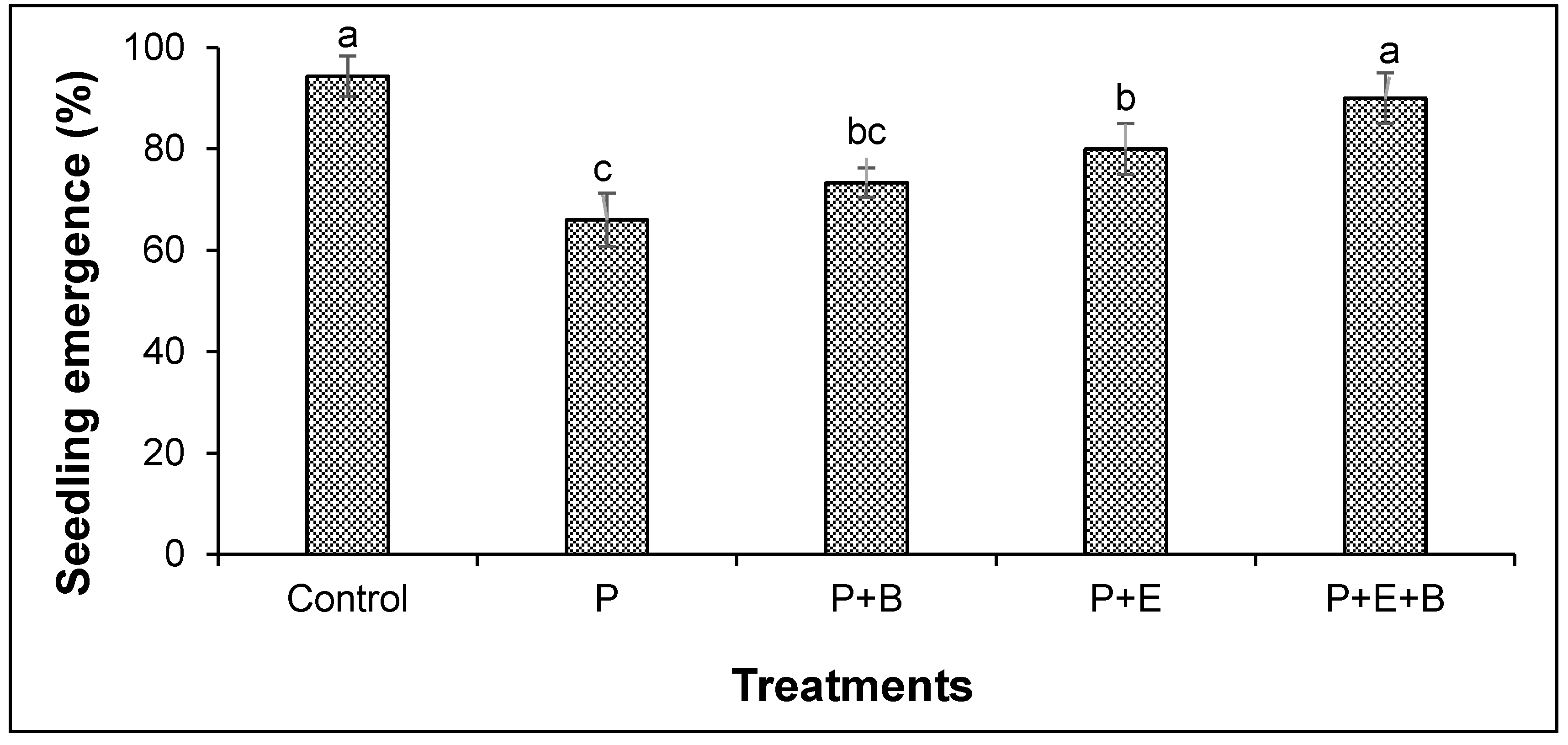
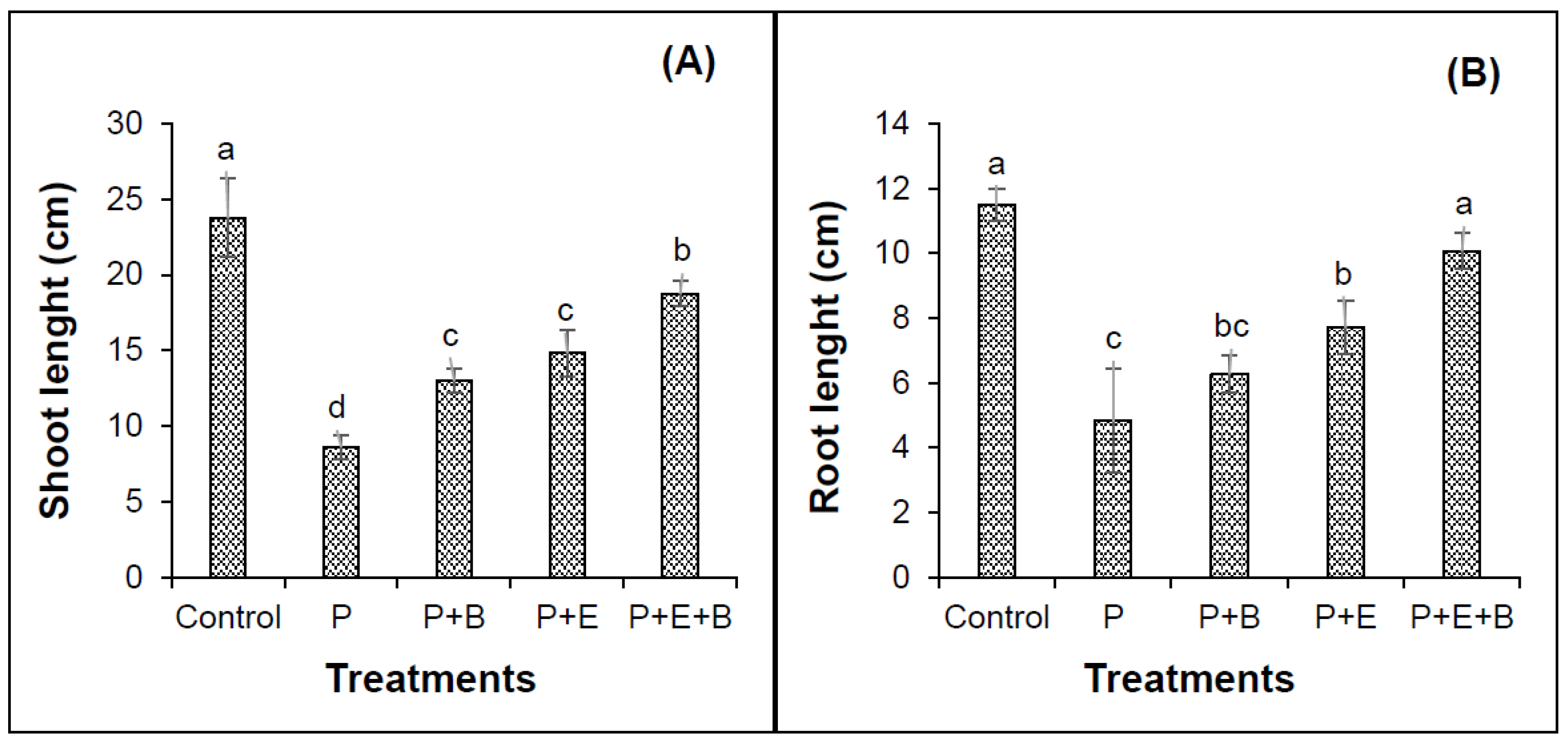
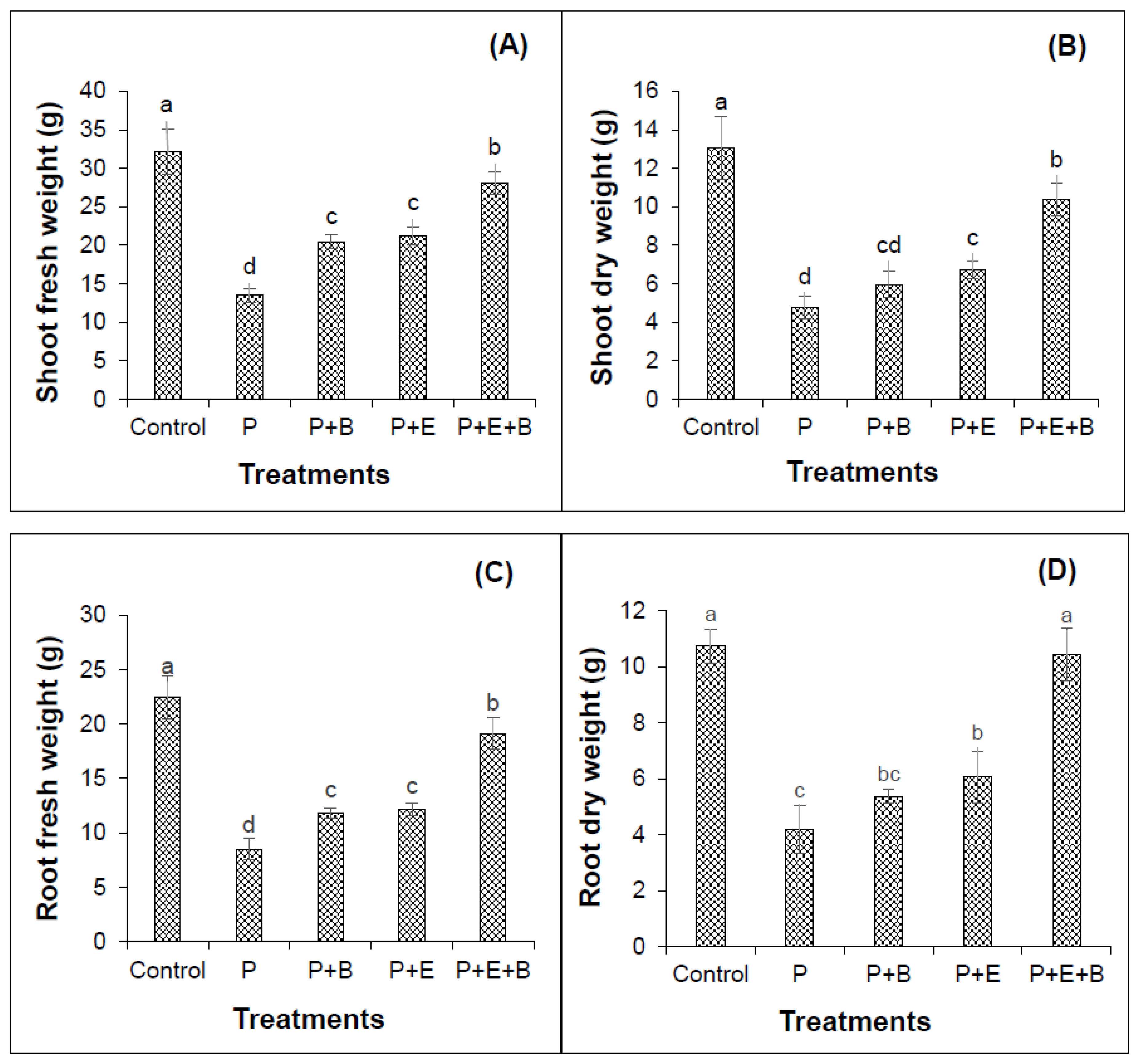

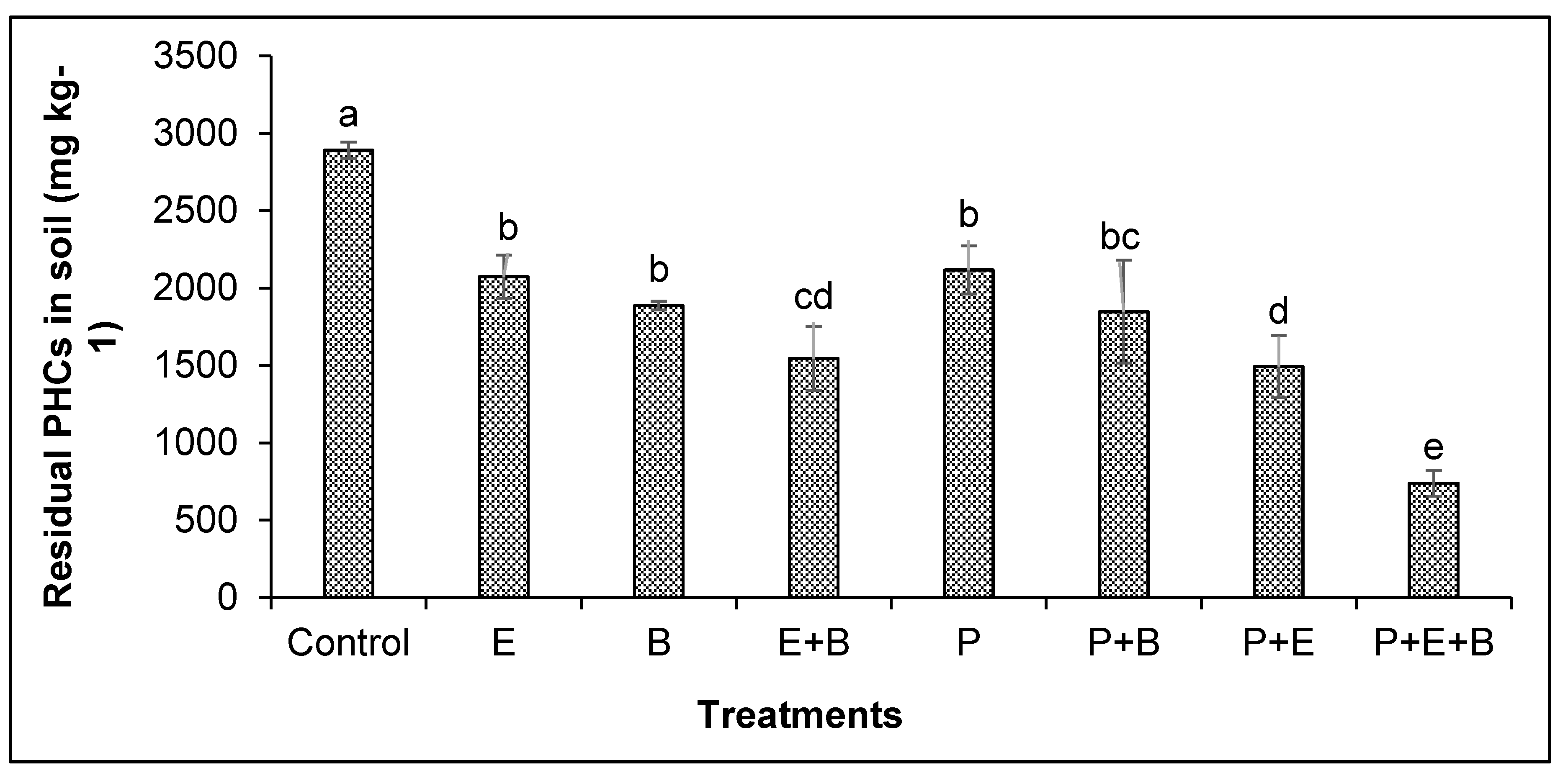
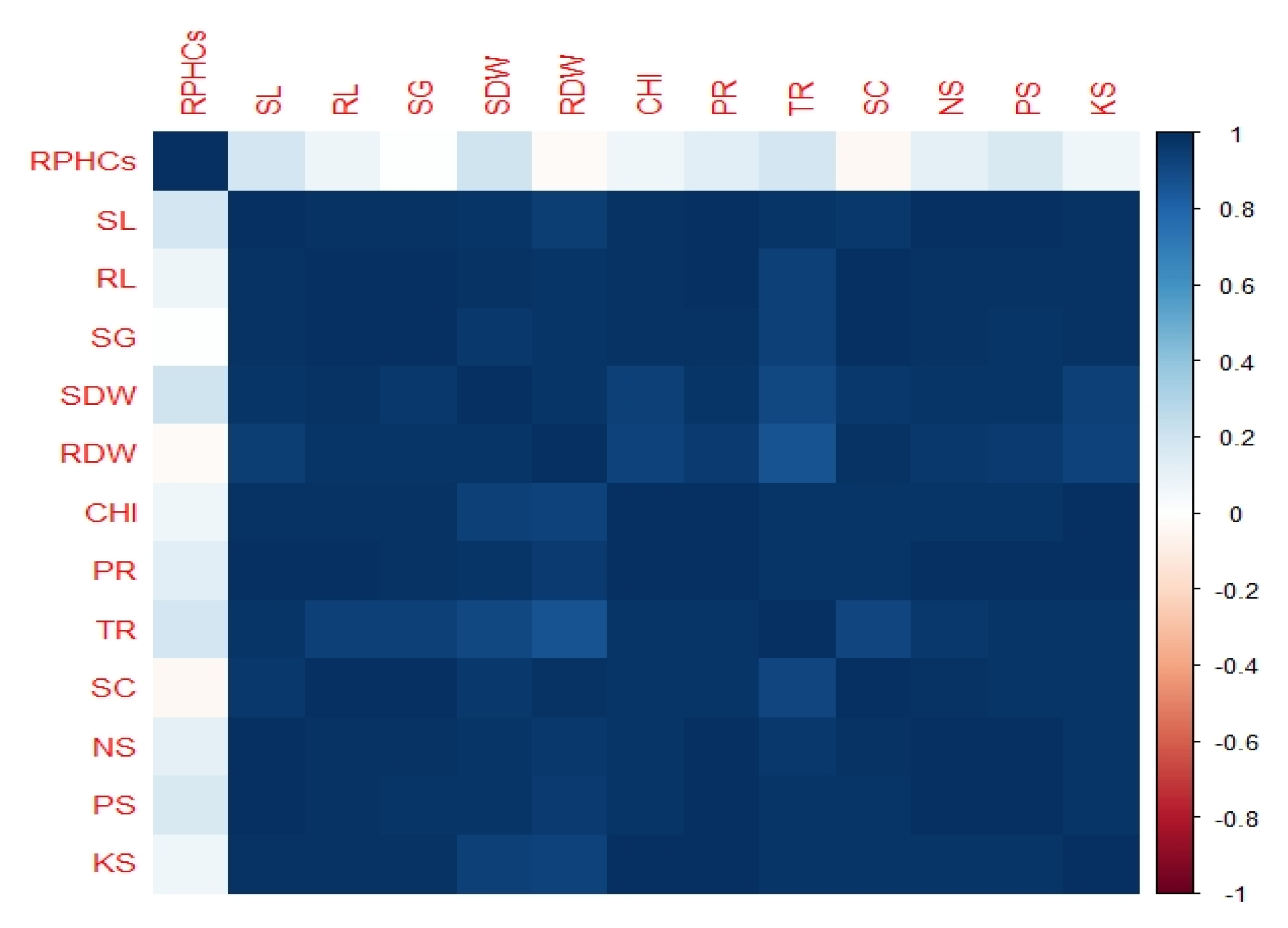
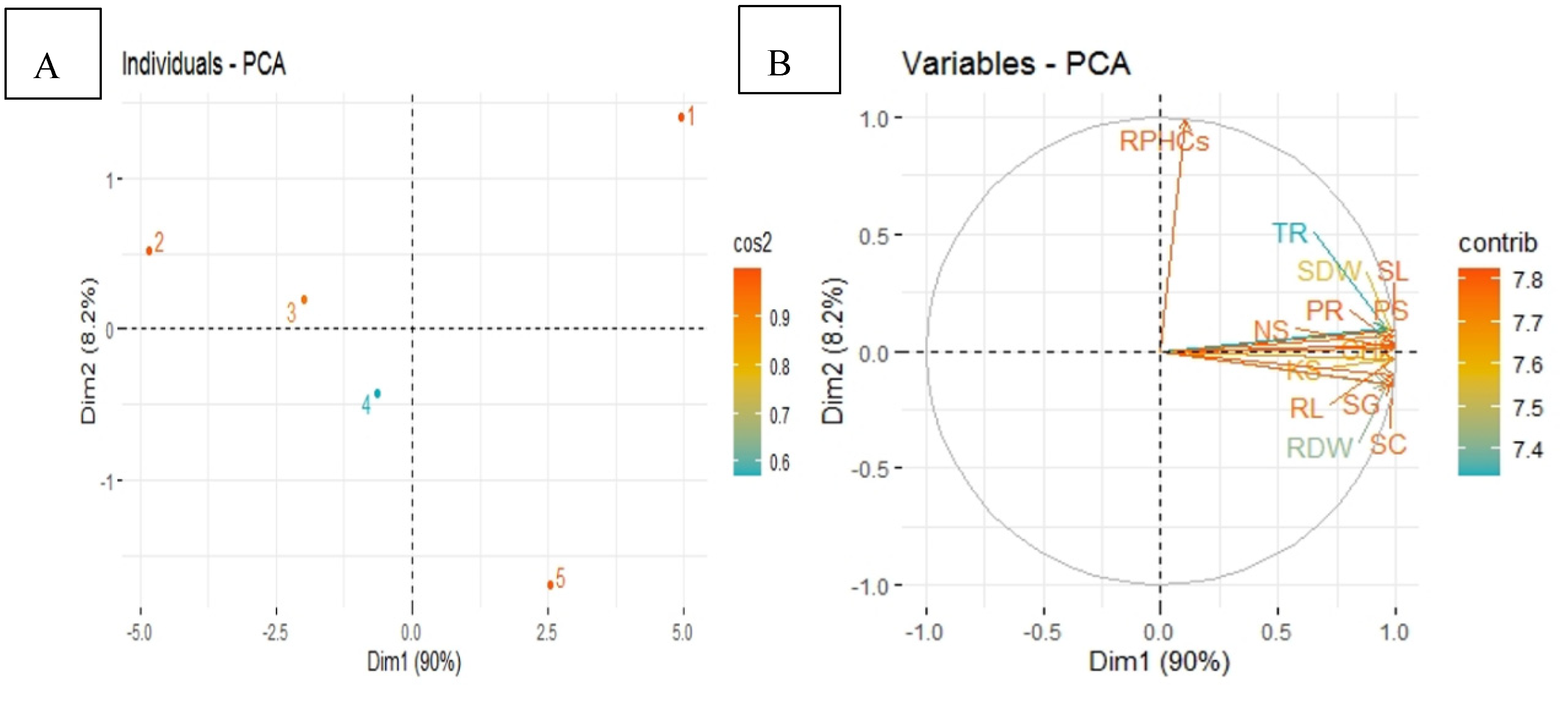
| Treatments | Lroot/Lshoot | FWroot/FWshoot | DWroot/DWshoot | SRL (m g−1) |
|---|---|---|---|---|
| Control | 0.488 ± 0.067 a | 0.700 ± 0.031 a | 0.824 ± 0.116 a | 0.011 ± 0.0005 a,b |
| P | 0.553 ± 0.150 a | 0.635 ± 0.109 a,b | 0.814 ± 0.019 a | 0.011 ± 0.0030 a,b |
| P+B | 0.484 ± 0.060 a | 0.577 ± 0.012 b | 0.909 ± 0.148 a | 0.012 ± 0.0010 a,b |
| P+E | 0.519 ± 0.107 a | 0.572 ± 0.015 b | 0.911 ± 0.170 a | 0.013 ± 0.0006 a |
| P+E+B | 0.534 ± 0.006 a | 0.681 ± 0.033 a | 1.006 ± 0.021 a | 0.008 ± 0.0014 b |
Publisher’s Note: MDPI stays neutral with regard to jurisdictional claims in published maps and institutional affiliations. |
© 2020 by the authors. Licensee MDPI, Basel, Switzerland. This article is an open access article distributed under the terms and conditions of the Creative Commons Attribution (CC BY) license (http://creativecommons.org/licenses/by/4.0/).
Share and Cite
Ali, M.H.; Sattar, M.T.; Khan, M.I.; Naveed, M.; Rafique, M.; Alamri, S.; Siddiqui, M.H. Enhanced Growth of Mungbean and Remediation of Petroleum Hydrocarbons by Enterobacter sp. MN17 and Biochar Addition in Diesel Contaminated Soil. Appl. Sci. 2020, 10, 8548. https://doi.org/10.3390/app10238548
Ali MH, Sattar MT, Khan MI, Naveed M, Rafique M, Alamri S, Siddiqui MH. Enhanced Growth of Mungbean and Remediation of Petroleum Hydrocarbons by Enterobacter sp. MN17 and Biochar Addition in Diesel Contaminated Soil. Applied Sciences. 2020; 10(23):8548. https://doi.org/10.3390/app10238548
Chicago/Turabian StyleAli, Muhammad Hayder, Muhammad Tayyab Sattar, Muhammad Imran Khan, Muhammad Naveed, Munazza Rafique, Saud Alamri, and Manzer H. Siddiqui. 2020. "Enhanced Growth of Mungbean and Remediation of Petroleum Hydrocarbons by Enterobacter sp. MN17 and Biochar Addition in Diesel Contaminated Soil" Applied Sciences 10, no. 23: 8548. https://doi.org/10.3390/app10238548






